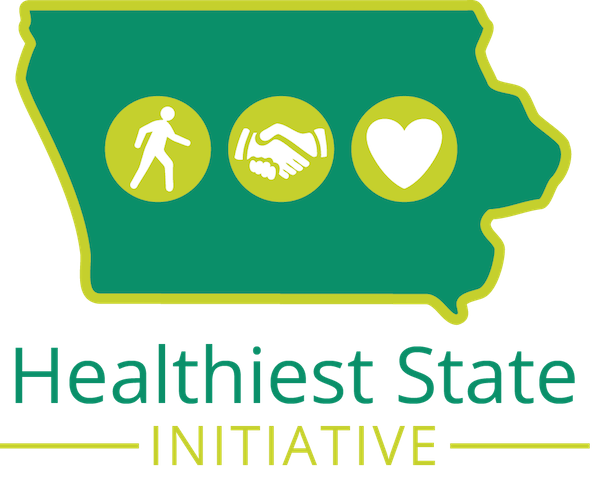How's Iowa Doing?
Together we are tracking and driving progress to improve the health of our state.
The process to benchmark the state is both complex and challenging. Our organization focuses on the progress of the specific goals set within the 5-2-1-0 Healthy Choices Count! Our rankings will reference to indexes; the Sharecare Community Well-being Index and America’s Health Rankings.
Although both indexes measure some similar health components, the methodologies of each vary greatly and, subsequently, provide different results on state rankings. Because the definition of ‘health’ is very broad (e.g. physical, social, emotional, etc.), the Healthiest State Initiative desires to review and benchmark both indexes when evaluating the health of all Iowans.
Note: Due to limited data available on youth (under 18 years of age), the dashboard includes data specific to Iowans 18 years of age and older. As data on youth becomes available, it will be incorporated as appropriate.
Overall Rankings
Sharecare Community Well-Being Index 2022
Current Rank: 33
Iowa ranks 33 of 50 states for overall well-being.
The Sharecare Community Well-Being Index® brings together more than 600 proven health risks into a single measure. By combining both individual and social factors, the index uniquely measures well-being across people and places. We based the index on decades of clinical research, health care leadership, and health economics. We conduct regular surveys within every community in the United States. We then analyze that data and score each community on a scale of 0 to 100. Updated every year, our current index is based on responses from more than 5 million surveys and 600+ social determinants of health. To learn more about the methodology of the Well-Being Index, you can visit this site.
America's Health Rankings
2024
Current Rank: 16
Iowa ranks 16 of 50 states for overall well-being.
America's Health Rankings® provides an analysis of national health on a state-by-state basis by evaluating a historical and comprehensive set of health, environmental and socioeconomic data to determine national health benchmarks and state rankings. The platform analyzes more than 340 measures of behaviors, social and economic factors, physical environment and clinical care data. Data is based on public-use data sets, such as the U.S. Census and the Centers for Disease Control and Prevention’s Behavioral Risk Factor Surveillance System (BRFSS), the world’s largest, annual population-based telephone survey of over 400,000 people. To learn more about the methodology of this index, you can visit this site.
Key Indicators
The Healthiest State Initiative is following four key indicators:
Obesity, Eat Well, Move More, and Feel Better.
Click on each indicator or scroll down to learn more!
Key Indicator #1: Obesity
Decrease Percentage of Iowans Who are Obese
Obesity is a complex problem which will require a multifaceted approach. Medical conditions that are obesity-related include heart disease, stroke, type 2 diabetes and certain types of cancer, and can be a leading cause of death. The medical costs for people who have obesity were $1,429 higher than those of normal weight. (Source: Health Affairs, Sept/Oct 2009)
Policy makers, state and local organizations, business and community leaders, school, childcare and healthcare professionals, and individuals must work together to create an environment that supports a healthy lifestyle in order to combat this national epidemic.
There is much more to learn about obesity in Iowa and the Iowa Healthiest State Initiative’s work to support Iowans living with obesity. Explore more information on our obesity page and learn more about how the Iowa Healthiest State Initiative’s programs are providing opportunities to reduce the risk of obesity:
OBJECTIVE #1:
MEASUREMENT:
% of adult (18+) Iowans who are obese.
Iowa Adults (% Obese)
Current Rate - 2024: 36.6%
CDC, National Center for Chronic Disease Prevention and Health Promotion, Division of Nutrition, Physical Activity, and Obesity. Data, Trend and Maps [online]. https://www.cdc.gov/nccdphp/dnpao/data-trends-maps/index.html *Additional IDPH analysis of national BRFSS data.
Key Indicator #2: Eat Well
Increase Number of Iowans Eating 5 or More Fruits and/or Vegetables Daily.
A diet rich in fruits and vegetables provides vitamins and minerals, important for supporting growth and development, and for optimal immune function in children. High daily intakes of fruits and vegetables among adults are associated with lower rates of chronic diseases such as heart disease, stroke, high blood pressure, diabetes, and possibly, some types of cancers. Emerging science suggests fruit and vegetable consumption may help prevent weight gain, and when total calories are controlled, may be an important aid to achieving and sustaining a healthy weight.
OBJECTIVE #1:
MEASUREMENT:
% of Iowans who consume 5 or more fruits and/or vegetables per day.
Consumption of Fruits/Vegetables
Current Rate - 2021: 12.1%
CDC, National Center for Chronic Disease Prevention and Health Promotion, Division of Nutrition, Physical Activity, and Obesity. Data, Trend and Maps [online]. https://www.cdc.gov/nccdphp/dnpao/data-trends-maps/index.html
*"Survey questions changed slightly in 2017 - beans and orange vegetables were replaced by potatoes. Click here to view the survey questions used during pre-2017 and in 2017."
Decrease Number of Sugar-Sweetened Beverage Individuals Consume Daily.
OBJECTIVE #2:
Sugar-sweetened beverages or sugary drinks are leading sources of added sugars in the American diet. Frequently drinking sugar-sweetened beverages is associated with weight gain/obesity, type 2 diabetes, heart disease, kidney diseases, non-alcoholic liver disease, tooth decay and cavities, and gout, a type of arthritis. Limiting the amount of sugar-sweetened beverages intake can help individuals maintain a healthy weight and have a healthy diet.
% of Iowans who do not drink regular soda or pop that contains sugar per day/week/month
MEASUREMENT:
Percent Who Don't Drink Soda or Pop
Current Rate - 2019: 39.0%
Source: Iowa BRFSS – State Added Nutrition
MEASUREMENT:
% of Iowans who do not drink sweetened fruit drinks per day/week/month
Percent of Iowans Who Don't Drink Sweetened Fruit Beverages
Current Rate - 2019: 56.6%
Source: Iowa BRFSS – State Added Nutrition
Percentage of Iowans Engaging at Least 30 Minutes of Physical Activity at Least Five Days a Week.
Regular physical activity is essential for weight maintenance and prevention of chronic diseases such as heart disease, diabetes, colon cancer, and osteoporosis. Physical activity is anything that gets your body moving! According to the 2018 Physical Activity Guidelines for Americans, you need to do two types of physical activity each week to improve your health: aerobic and muscle-strengthening (1).
We know 150 minutes each week sounds like a lot of time, but it's not. That's 2 hours and 30 minutes, about the same amount of time you might spend watching a movie. The good news is that you can spread your activity out during the week, so you don't have to do it all at once. You can even break it up into smaller chunks of time during the day. It's about what works best for you, as long as you're doing physical activity for at least 10 minutes at a time.
References: Centers for Disease Control and Prevention - Physical Activity Basics (https://www.cdc.gov/physicalactivity/basics/index.htm)
Key Indicator #3: Move More
OBJECTIVE #1:
% of Iowans who achieve at least 150 minutes/week of moderate-intensity aerobic physical activity or 75 minutes/week of vigorous-intensity aerobic physical activity.
MEASUREMENT:
Percent Who Engage in Physical Activity
Current Rate - 2023: 58.6%
CDC, National Center for Chronic Disease Prevention and Health Promotion, Division of Nutrition, Physical Activity, and Obesity. Data, Trend and Maps [online]. https://www.cdc.gov/nccdphp/dnpao/data-trends-maps/index.html
Decrease Recreational Screen Time to Less than 2 Hours a Day
A 2014 Nielsen report found that adults log a total of 11 hours of screen time a day. This takes a toll on our overall health as even two hours of television (TV) a day can increase the risk of weight gain, vision problems, sleep disturbances, poor posture leading to shoulder and neck pain, weight gain, diabetes and heart disease in adults. Since we are sitting down during most of our screen-time, this boosts the risk of obesity, heart disease, type 2 diabetes and some types of cancer.
Note: 2019 is the first year this information was collected.
OBJECTIVE #2:
% of Iowans who spend two or more hours watching television or playing videos.
MEASUREMENT:
Percent Who Spend 2+ Hours of Screen Time Per Day
Current Rate - 2021: 73.2%
Key Indicator #4: Feel Better
Decrease Number of Iowans that Use Tobacco
Despite declines in cigarette usage since the mid-1960s, about one in four Iowa adults continues to smoke. Tobacco use remains the leading cause of preventable death in the state. Of the 28,000-29,000 deaths among Iowans each year, it's estimated that about one in six are caused by tobacco (1).
Iowans who smoke experience elevated risk of heart disease, stroke, cancer, chronic lung disease, osteoporosis, physical disability and women who smoke risk giving birth to premature and low birth weight babies. Cigarette use imposes an annual economic burden of $1.28 billion in health care costs, including $364.5 million in state Medicaid program expenditures, and $1.21 billion in smoking-related lost productivity costs (2).
OBJECTIVE #1:
MEASUREMENT:
% of adult (18+) who are current cigarette smokers.
Percent of Adult Iowans Who Smoke Cigarettes
Current Rate - 2024: 12.9%
CDC, National Center for Chronic Disease Prevention and Health Promotion, Division of Population Health. BRFSS Prevalence & Trends Data. View Source *Additional IDPH analysis of national BRFSS data.
Increase Percentage of Iowans Volunteering
Over the past two decades there has been a growing body of research that indicates volunteering provides individual health benefits in addition to social benefits. This research has established a strong relationship between volunteering and health: Those who volunteer have lower mortality rates, greater functional ability, and lower rates of depression later in life than those who do not volunteer (3).
OBJECTIVE #2:
MEASUREMENT:
% of Iowa residents who volunteer.
Percent of Iowans Reporting ‘Not Good’ Mental Health
Current Rate - 2024: 14.9%
UnitedHealth Foundation. America's Health Rankings analysis of BRFSS. *Additional IDPH analysis of national BRFSS data. View Source
Increase Resiliency Among Iowans
Good mental health and wellbeing is fundamental to our physical health, relationships, education, training, work and to achieving our potential.
The benefits of positive mental health and well-being are wide ranging and significant both for individuals and for society as a whole. Positive mental health is associated with an increase in life expectancy, improved quality of life, improved physical outcomes, improved education attainment, increased economic participation, and positive social relationships (4).
OBJECTIVE #3:
% of adult Iowans reported their mental health was not good 14 or more days in the past 30 days.
MEASUREMENT:
Percent of Iowans Volunteering
Current Rate - 2024: 55.0%
NOTE: 2015 & 2018 data source: Corporation for National & Community Service 2019-2023 data source: Iowa BRFSS
References:
1 Tobacco Use Among Iowa Adults 2011-14, Iowa Department of Public Health (https://idph.iowa.gov/Portals/1/userfiles/115/surveillance,%20evaluation%20and%20statistics/updates%20oct%2016/AdultPrevTrendRPT201114_CgtSmklsl_160720l.pdf)
2 The Burden of Tobacco Use in Iowa in 2016, Iowa Department of Public Health (http://idph.iowa.gov/Portals/1/userfiles/115/surveillance,%20evaluation%20and%20statistics/The%20Burden%20of%20Tobacco%20Use%20in%20Iowa%202016_Cmmnt_170126%20(4)%20(1).pdf)
3 Corporation for National and Community Service - The Health Benefits of Volunteering 2007 (https://www.nationalservice.gov/pdf/07_0506_hbr.pdf)
4 Centers for Disease Control and Prevention - Learn about Mental Health (https://www.cdc.gov/mentalhealth/learn/index.htm)


